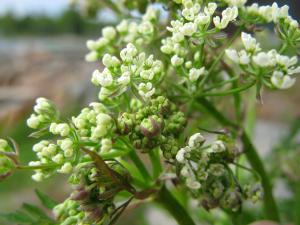Wild chervil is an herbaceous plant that establishes as a tosette with fern-like leaves persisting for at least one year. Plants flower in subsequent years (typically second year), but after plants flower, they die (monocarpic perennial). Mature plants typically have a 1-5′ tall stem that is branches, hallow, grooved, and hairy with a fringe of hairs around lower nodes.
Legal classification in Wisconsin: Prohibited/Restricted
Leaves: Stem leaves are pinnately compound, alternate, fern-like, triangular, and usually hairy on the underside, especially along the veins. Total leaf grows up to 1′ long, while each leaf segment is 0.5-2″ long. Leaflets are 2-3, pinnately divided, and clasp the stem. Petioles are grooved on upper surface. Rosette leaves are similar to stem leaves.
Flowers: Late spring to early summer. Creamy white flowers with five notched petals found in flat-topped umbels, 8-24″ across. Each flower is 0.1-0.2″ in diameter.
Fruits and seeds: Narrow fruit are somewhat wider near the base, smooth, and 0.2″ long. Fruits are initially green, turning brown as they mature.
Roots: Taproot up to 6′ long. Also reproduces from buds at the top of the root. After parent plant flowers and completes life cycle, these side buds often become independent plants.
Similar species: Wild Chervil is often confused with other species in teh parsley family (Apiaceae). A key characteristic to distinguish wild chervil from other plants in this family is the presence of small tooth-like hairs at the top of the flowering stems. Three members of the parsley family that are confused with wild chervil are wild carrot (Daucus carota), sweet cicely (Osmorhiza sp.), and the hedge-parselys (Torilis sp.). These plants can be distinguished from wild chervil as they bloom from late spring to early summer, compared to spring. In addition, wild carrot has large curved bracts under each umbel, sweet cicely has leaves that are fragrant when crushed, and hedge-parsely fruit are covered in bristles.
Ecological threat:
• Invades forest edges, fields, pastures, fencerows, roadsides, and disturbed areas.
For more information visit: http://dnr.wi.gov/topic/Invasives/fact/WildChervil.html
Photo released under creative commons license.

